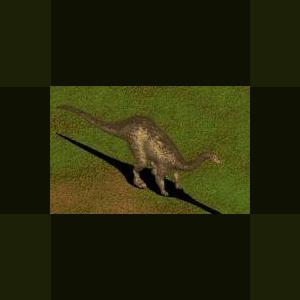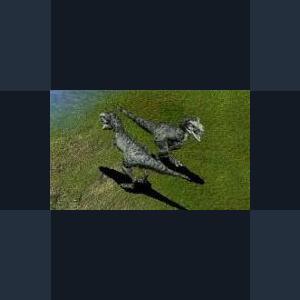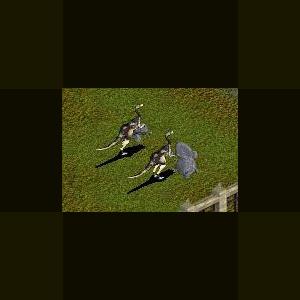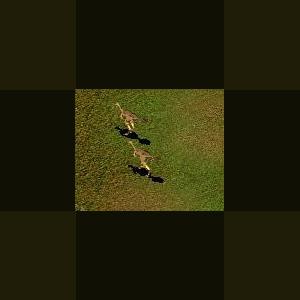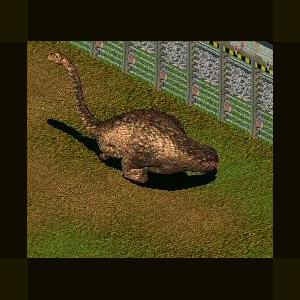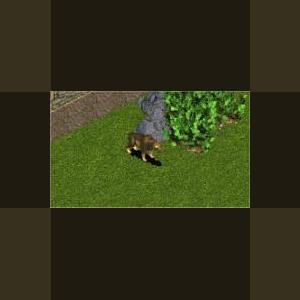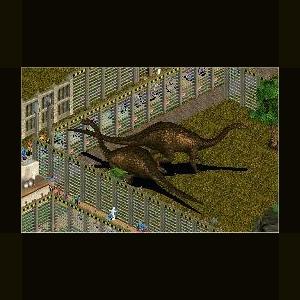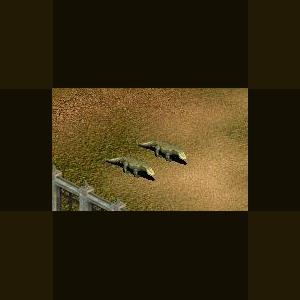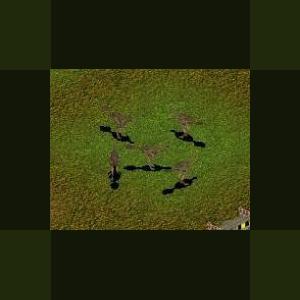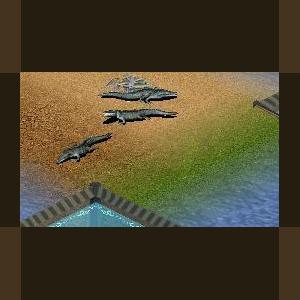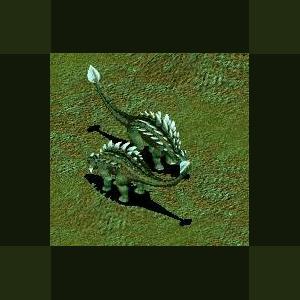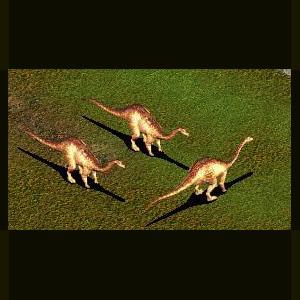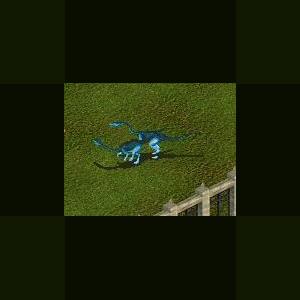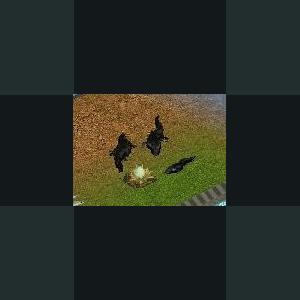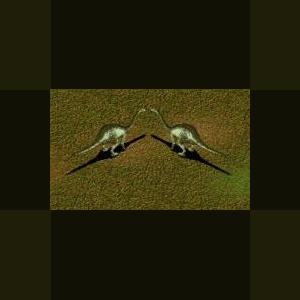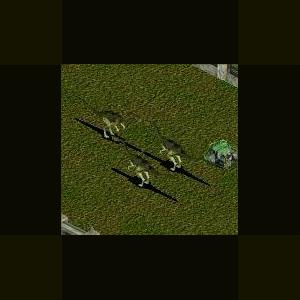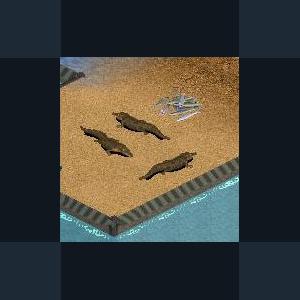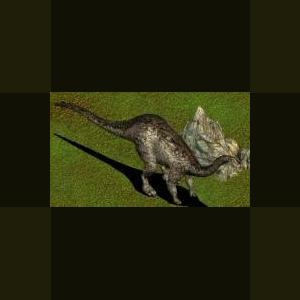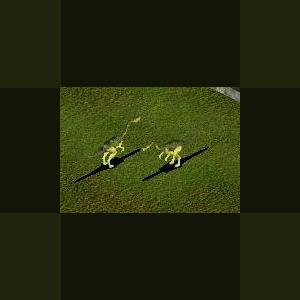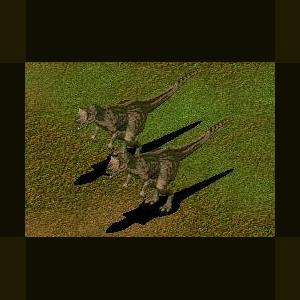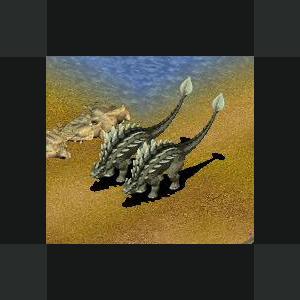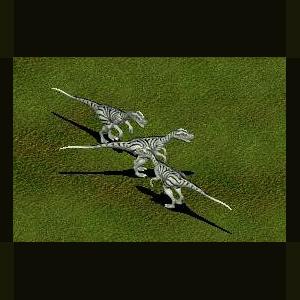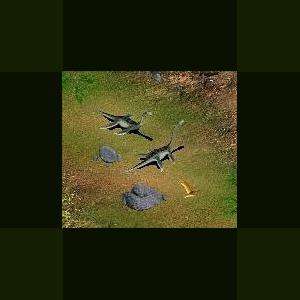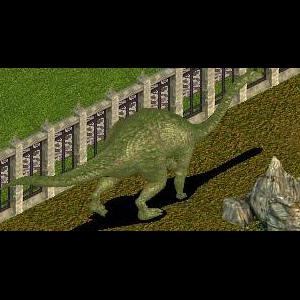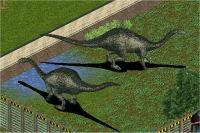Dinosaurs
Creatures from another age
241 files
-
Austrosaurus by Moondawg
By Guest
Austrosaurus (meaning "Southern lizard") was a sauropod dinosaur from the Winton Formation, from the early Cretaceous (98-95 Million Years ago) of Central-Western Queensland in Australia.
The remains were discovered by Mr. H.B. Wade on Clutha Station near Maxwelton in north Queensland in 1932, who alerted the station manager H. Mackillop, who showed his brother who sent them to the Queensland Museum. Austrosaurus was described by Heber Longman in 1933.
In 1999 on a property near Winton in central-western Queensland, Australia, grazier Dave Elliott found a sauropod femur belonging to what turned out to be the largest dinosaur discovered in Australia to that date, which was nicknamed 'Elliot'. At the Winton find, a right femur and portions of several ribs have so far been uncovered. A smaller sauropod, nicknamed 'Mary', after Dr Mary Wade, has also been uncovered. Early indications are that they are closely related to Austrosaurus mackillopi and either in the same or closely related genus.
On 3 May 2007, bones from the remains of two huge titanosaurs which were uncovered in 2004 near Eromanga in south-west Queensland went on display at the Queensland Museum, in Brisbane. This find was described by the ABC news service as the largest bones now discovered to date in Australia, eclipsing 'Elliot'.
Originally it was thought that the Austrosaurus had a tendency to spend time near or in water to relieve weight from their legs. However, this theory is now rejected and it is thought that the Austrosaurus preferred hard, dry land. Fossil finds suggest a height of approximately 3.9 metres at the hip and 4.1 metres at the shoulder, which would have given it an almost level back.
Initially, Austrosaurus was considered a cetiosaurid, like Patagosaurus or Shunosaurus. However, a recent reappraisal of material by Ralph Molnar has found that it, and the newer remains of 'Eliot', are titanosaurid, as various features on the vertebrae show.
197 downloads
0 comments
Updated
-
Aviatyrannis by Moondawg
By Guest
Aviatyrannis is a genus of tyrannosaurid dinosaur from the Kimmeridgian stage of the Late Jurassic found in Portugal.
It was described by Oliver Rauhut in 2003. The name means "Jurassic grandmother tyrant". It is one of the oldest tyrannosaurs ever found, the oldest being Guanlong (or Iliosuchus if it is indeed tyrannosauroid).
Aviatyrannis was perhaps a contemporary of another ancient tyrannosaur, the American Stokesosaurus. Aviatyrannis was even originally assigned to Stokesosaurus, and its fragmentary remains maintain the question of their synonymity open.
Like other early tyrannosaurs, Aviatyrannis was rather small. The holotype, for example, is an ilium only 90 millimeters long. The type species, Aviatyrannis jurassica, was described by Rauhut in 2003.
Inspired by the Zoo Tek Brains Trust
226 downloads
Updated
-
Avimimus by Moondawg
By Guest
Avimimus was a small dinosaur, standing about 45 centimeters (2.5 ft) tall at the hips and
a length of 1.5 m (5 ft). The skull was relatively small compared to the body, though the
brain and eyes were relatively large. The size of the bones which surrounded the brain and
were dedicated to protecting it are large. This is also consistent with the hypothesis
that Avimimus had a proportionally large brain.
As in the related Oviraptoridae and Caenagnathidae, the jaws of Avimimus formed a
parrot-like beak, and lacked teeth. However, a series of toothlike projections along the
tip of the premaxilla would have given the beak a serrated edge. The toothless beak of
Avimimus suggests that it may have been an herbivore or omnivore. Kurzanov himself,
however, believed that Avimimus was an insectivore.
The foramen magnum, the hole allowing the spinal cord to connect with the brain, was
proportionally large in Avimimus. The occipital condyle, however, was small, further
suggestive of the skull's relative lightness.The neck itself was long and slender, and is
composed of vertebrae are much more elongate than in other oviraptorosaurs. Unlike
oviraptorids and caenagnathids, the back vertebrae lack openings for air sacs, suggesting
that Avimimus is more primitive than these animals.
The forelimbs were relatively short. The bones of the hand were fused together, as in
modern birds, and a ridge on the ulna (lower arm bone) was interpreted as an attachment
point for feathers by Kurzanov.Kurzanov, in 1987, also reported the presence of quill
knobs, and while Chiappe confirmed the presence of bumps on the ulna, their function
remained unclear. Kurzanov was so convinced they were attachment points for feathers that
he concluded that Avimimus may have been capable of weak flight. This interpretation has
not seen wide support among paleontologists, however.
The ilium was almost horizontally oriented, resulting in exceptionally broad hips. Little
is known of the tail but the hip suggests that the tail was long. The legs were extremely
long and slender, suggesting that Avimimus was a highly specialized runner. The
proportions of the leg bones add further weight to the idea of Avimimus was quick on its
feet. The animal's shins were long in comparison with its thighs, a trait common among
cursorial animals. It also had three-toed feet with narrow pointed claws.
Its remains were discovered in the Djadokta Formation by Russian paleontologists, and
officially described by Dr. Sergei Kurzanov in 1981. The type species is A. portentosus.
Because no tail was found with the original find, Dr. Kurzanov mistakenly concluded that
Avimimus lacked a tail in life. However, subsequent Avimimus finds containing caudal
vertebrae have confirmed the presence of a tail.
In 1991, Sankar Chatterjee erected the Order Avimimiformes to include Avimimus, though
this group is not used by most paleontologists today as it includes only a single species.
281 downloads
Updated
-
Bambiraptor by Moondawg
By Guest
The Bambiraptor skeleton was discovered in 1995 by 14-year-old fossil hunter Wes Linster, who was looking for dinosaur bones with his parents near Glacier National Park in Montana. Linster told Time Magazine that he uncovered the skeleton on a tall hill and was amazed at his discovery. "I bolted down the hill to get my mom because I knew I shouldn't be messing with it", he said. The bones that Linster discovered on that hilltop led to the excavation of a skeleton that was approximately 95 percent complete. Because of its completeness Florida Paleontology Institute Director Martin Shugar compared it to the 'Rosetta Stone' that enabled archaeologists to translate Egyptian hieroglyphics. Yale paleontologist John Ostrom, who reintroduced the theory of bird evolution from dinosaurs after his 1964 discovery of Deinonychus in Wyoming, agreed, calling the specimen a "jewel", and telling reporters that the completeness and undistorted qualities of the bones should help scientists further understand the dinosaur-bird link. The specimen is currently housed at the American Museum of Natural History, New York.
During the conference where Bambiraptor was first introduced, the dinosaur reconstruction specialist Brian Cooley portrayed Bambiraptor as having feathers, despite the fact that no feathers were found with the fossil itself. His decision was influenced by the fact that because Bambiraptor within a cladistic analysis was a member of a group, Paraves, that contained feathered true birds and that was the sister taxon of Oviraptorosauria, a group that also had feathered forms (e.g. Caudipteryx), Bambiraptor most likely had feathers too due to phylogenetic bracketing. Most paleontologists support Cooley's view, and subsequent discoveries confirmed that small dromaeosaurid dinosaurs like Bambiraptor were fully covered in feathers.
Research done at Lamar State College in Orange, Texas has indicated that Bambiraptor may have had opposable front claws and a forelimb maneuverability that could reach its mouth. This would have given the animal the ability to "hold" food in its front limbs and place it in its mouth, in a similar manner to some modern-day small mammals.
Bambiraptor skull in the Oxford University Museum of Natural History.Bambiraptor had a brain size in the lower range of modern birds. Because of its enlarged cerebellum, which may indicate higher agility and higher intelligence than other dromaeosaurs, David A. Burnham has hypothesized that Bambiraptor feinbergi may have been arboreal. Life in the trees may have required evolutionary pressure that resulted in a larger brain. Burnham also offers an alternative hypothesis that a larger brain could be selected for as a result of hunting more agile prey items such as lizards and mammals. Bambiraptor had the largest brain for its size of any dinosaur yet discovered, although the brain size may be due to its age, because juvenile animals tend to have larger brain-to-body ratios compared to adults. It also had very long arms and a well-developed wishbone.
232 downloads
0 comments
Updated
-
Barapasaurus by Moondawg
By Guest
Barapasaurus is curious because it is the earliest known sauropod, dating from the early Jurassic Period — more precisely the Toarcian age, about 189.6 to 176.5 million years ago. This is evident in the unspecialized nature of its form. Later sauropods like Brachiosaurus developed their own ecological niche and feeding strategies. However, Barapasaurus was something of an "all-purpose" dinosaur. For example, later sauropods developed hollow vertebrae, as a weight-saving measure. Barapasaurus vertebrae, on the other hand, were almost solid, with only the earliest hints of hollowing. (See also: Camarasaurus.)
Despite its early place in dinosaur history, Barapasaurus reached a length of about 18 metres (60 feet), and weighed about 48 tones (53 tons). Its height to the hip was approximately 5.5 metres (18 feet).
Like all sauropods, Barapasaurus was a herbivore. However, no skull has yet been recovered and so its exact diet has not been determined. A few lone teeth are known but not sufficient to make judgments on diet.
Barapasaurus is also important because, although its remains were found in India, it is very similar to other samples found in East Africa. From this we can conclude that during the early Jurassic period, these two land masses were still connected or at least only recently divorced.
Barapasaurus is included in Vulcanodontidae rather than Cetiosauridae, another family in Sauropoda. This classification is unconfirmed since insufficient work has been done on the skeletons. The description is justified by the narrow sacrum (a boxlike structure of the hip), which is a characteristic of vulcanodontids. However, the dorsal vertebrae display features shared with Cetiosauridae, such as a high neural arch above the vertebral foramen.
Currently the only known species is the original B. tagorsi.
The first bones of Barapasaurus were recovered in India in 1960. However, it was not until 1975 that this recovery was made the type specimen, and the official description published by Jain, Kutty, Roy-Chowdhury and Chatterjee of Calcutta.
Since then, five additional skeletons have been recovered from the Godavari Valley in southern India. However, none of these included the skull or feet. The remainder of the skeleton is known, so it is theoretically the best-known of the early Jurassic sauropods. Unfortunately, little work has yet been published regarding these discoveries.
295 downloads
0 comments
Updated
-
Barbourofelis Fricki by Ghirin
By Guest
Barbourofelis fricki
Author: Ghirin
Barbourofelis fricki ("Barbour's Cat") was a lion-sized member of the genus Barbourofelis from the family Nimravidae. Even though Barbourofelis strongly resembled the saber-toothed cats, the nimravids are no longer considered to be true felines due to distinct anatomical differences and are sometimes referred to as paleo-sabers or false saber-toothed cats.
Barbourofelis fricki was one of the last of the genus and roamed the North American grasslands approximately 6 million years ago.
285 downloads
0 comments
Updated
-
Barosaurus by Ghirin
By Guest
Barosaurus (“Heavy Lizard”) was a member of the Diplodocidae and a close relative of both Apatosaurus and Diplododus. This particular family of sauropods was named after the beam-shaped bones in their tails.
Barosaurus fossils have been been found in two locations. It ws first identified in western North America. Recently, Barosaurus fossils have been discovered in Tanzania.
References:
http://dinosauricon.com/genera/barosaurus.html
Encyclopedia of Dinosaurs and Other Prehistoric Creatures. Malam and Parker, 2002
Dinosaurs. Parker, 2003
Created by Ghirin 2004
253 downloads
0 comments
Updated
-
Baurusuchus by Moondawg
By Guest
Baurusuchus is an extinct genus of baurusuchid mesoeucrocodylian from the Late Cretaceous of South America.
324 downloads
Updated
-
Beipiaosaurus by Moondawg
By Guest
Beipiaosaurus is a genus of therizinosauroid theropod dinosaur.
The discovery of Beipiaosaurus , which translates as "Beipiao lizard" after a city in China near the location of its discovery, was announced in the May 27, 1999, issue of the journal Nature. These fossils were found in Liaoning Province, China and have been dated to the early Cretaceous Period, about 125 million years ago. It is known from a single species, B. inexpectus, named for "the surprising features in this animal.". A significant number of fossilized bones for this species were recovered, including: cranial fragments, a mandible, three cervical vertebrae, four dorsal vertebrae, a caudal vertebra, the scapula and scapulacoracoid, a complete forelimb, and a complete pelvis with hindlimb.
The exact classification of therizinosaurs had in the past been hotly debated, since their prosauropod-like teeth and body structure indicate that they were generally herbivorous, unlike typical theropods. Beipiaosaurus, being considered to be a primitive therizinosauroid, has features which suggest that all therizinosauroids, including the more derived Therizinosauridae, to be coelurosaurian theropods, not sauropodomorph or ornithischian relatives as once believed.
Beipiaosaurus measured 2.2 meters (7.3 ft) in length and .88 meters (2.9 ft.) tall at the hip, and is among the largest known feathered dinosaurs. Its weight is estimated as about 85 kg (187 lb.) Beipiaosaurus had a toothless beak with cheek teeth. More advanced therizinosaurids have four functional toes, but the feet of Beipiaosaurus' have reduced inner toes, showing that the derived therizinosaurid condition may have evolved from a three-toed therizinosauroid ancestor. The head was large relative to other therizinosaurs, and it had some features similar to the related oviraptorosaurs. The fossil's skin impressions indicate its body was covered by downy feather-like fibers, which are similar to those of Sinosauropteryx, but longer, and are oriented perpendicular to the arm. Xu et al. suggest that the feathers of Beipiaosaurus represent an intermediate stage between Sinosauropteryx and more advanced birds (Avialae). As only theropod dinosaurs are so far known to have been feathered, this discovery is further evidence that therizinosaurs were indeed theropods.
213 downloads
0 comments
Updated
-
Bernissartia by Moondawg
By Guest
Bernissartia is one of the smallest crocodylians that ever lived. It resembled modern species and was probably semi-aquatic. It had long, pointed teeth at the front of the jaws would have been of use in catching fish, while the broad and flat teeth at the back of its jaws would have facilitated crushing hard food, such as shellfish and possibly bones. It lived during the early Cretaceous in modern day England and Belgium.
269 downloads
0 comments
Updated
-
Bissektipelta by Moondawg
By Guest
Bissektipelta is an ankylosaurid dinosaur from the Upper Cretaceous of Uzbekistan. The holotype and only known specimen was collected from the Bissekty Formation (lateTuronian-Coniacian).
The holotype consists of a braincase and incomplete skull roof, along with isolated teeth and osteoderms. Originally, this material was referred to the genus "Amtosaurus", but was reassigned to a new taxon when that genus was declared a nomen dubium. Bissektipelta is presently monospecific, containing only B. archibaldi. The holotype was collected in September of 1998 by the joint Usbek-Russian-British-American-Project. This specimen can be distinguished from "A. magnus" in having three exits for N. hypoglossus instead of two, by the lesser angle between ventral surfaces of basisoccipital and basisphenoid, and by the more caudally situated basispterygoid processes.
420 downloads
Updated
-
Blikanasaurus by Moondawg
By Guest
Blikanasaurus
Blikanasaurus (meaning "Blikana lizard") was a genus of sauropodomorph dinosaur found in Lower Elliot Formation rocks from the Late Triassic in what is now South Africa's Cape Province. Known from a left lower limb only, it has been variously classified as a prosauropod or basal sauropod. The type species, Blikanasaurus cromptoni, was first described by Galton and van Heerden in 1985
224 downloads
0 comments
Updated
-
Borogovia by Moondawg
By Guest
Borogovia was a theropod dinosaur which lived during the Late Cretaceous Period, in what is now Mongolia.
The agile carnivorous troodontid takes its name from creatures known as 'borogoves' in the Lewis Carroll poem, Jabberwocky.
Known only by partial hind limbs, the Borogovia was 2 meters (6 feet) long and weighed 13 kilograms (27 pounds).
205 downloads
0 comments
Updated
-
Brachychampsa by Moondawg
By Guest
This freshwater, carnivorous reptile is among the very earliest alligatoroids known to science.
The first Brachychampsa fossil was discovered in Montana's heck Creek Formation—an ancient suite of rocks that was laid down near the end of the Cretaceous period. That individual animal lived not so long before the Cretaceous-Tertiary extinction that wiped out many of Earth's species some 65 million years ago.
Brachychampsa had short teeth and a large mouth that packed more power than those of living gators. These oral characteristics suggest that Brachychampsa may have preyed on turtles, which were very common in the heck Creek fauna.
The first alligator ancestors evolved some 245 million years ago. About 80 million years ago, during the Cretaceous period, crocodilians appeared. This group includes alligatoroids, such as Brachychampsa, as well as their close relatives the crocodiles and caimans.
Many of these ancient animals were survivors of the Cretaceous-Tertiary extinction, though no one knows why they lived when so many others perished.
Modern alligators are still closely related to their ancient ancestors and look much like their relatives did 80 million years ago.
This animal was tricky :D but i managed to get the eggs to hatch :D
272 downloads
0 comments
Updated
-
Brachytrachelopan by Moondawg
By Guest
Brachytrachelopan is an unusual short-necked sauropod dinosaur from the latest Jurassic Period (Tithonian) of Argentina.
The holotype and only known specimen (Museo Paleontológico Egidio Feruglio) was collected from an erosional exposure of fluvial sandstone within the Cañadón Cálcero Formation on a hill approximately 25 km north-northeast of Cerro Cóndor, Chubut Province, in west-central Argentina, South America. Though very incomplete, the skeletal elements recovered were found in articulation and include eight cervical, twelve dorsal, and three sacral vertebrae, as well as proximal portions of the posterior cervical ribs and all the doral ribs, the distal end of the left femur, the proximal end of the left tibia, and the right ilium. Much of the specimen was probably lost to erosion many years before its discovery. The type species was named in honor of Daniel Mesa, a local shepherd who discovered the specimen while searching for lost sheep. The genus name translates as "short-necked Pan", Pan being the god of the shepherds.
193 downloads
0 comments
Updated
-
Byronosaurus by Moondawg
By Guest
Byronosaurus
Byronosaurus was a troodontid dinosaur which lived during the Late Cretaceous Period. It was named for Byron Jaffe, "in recognition of his family's support for the Mongolian Academy of Sciences-American Museum of Natural History Paleontological Expeditions." The first example of Byronosaurus was discovered in 1993 at Ukhaa Tolgod, Gobi Desert, Mongolia; a second was found in 1996 at Bolor's Hill, about 8 kilometers away (5 miles).
Byronosaurus was a small, agile dinosaur that was probably only 1.5 meters long (5 ft) and 50 centimeters high (17 in). It weighed only about 4 kilograms (9 lbs). Unlike most other troodontids, its teeth seem to lack serrations. They are instead needle-like, probably best suited for catching small birds, lizards and mammals. Specifically, they resemble those of Archaeopteryx, the bird-like dinosaur.
The remains of two individuals have been found, including two skulls. One, measuring 23 centimeters long (8 inches), is better preserved than any other troödontid skull found to date. It has a chamber in the snout where air enters from the nostrils before passing through to the mouth - another feature similar to that found in birds.
169 downloads
0 comments
Updated
-
Calsoyasuchus by Moondawg
By Guest
Calsoyasuchus
Calsoyasuchus (meaning "[Dr. Kyril] Calsoyas' crocodile") is a genus of goniopholidid mesoeucrocodylian that lived in the Early Jurassic. Its fossilzed remains were found in the Sinemurian-Pliensbachian-age Kayenta Formation on Navajo Nation land in Coconino County, Arizona, United States. Formally described as C. valliceps, it is known from a single incomplete skull which is unusually derived for such an early crocodile relative. This genus was described in 2002 by Ronald Tykowski and colleagues; the species name means "valley head" and refers to a deep groove along the midline of the nasal bones and frontal bones.
The holotype skull that would be named Calsoyasuchus was discovered in 1997 by members of an expedition composed of crews from Texas Memorial Museum of the University of Texas at Austin, the Museum of Comparative Zoology at Harvard University, and the Seba Dalkai Navajo Nation School. It was found in the middle third of the silty facies of the Kayenta Formation, near the Adeii Eechii Cliffs. The skull is missing the lower jaws, part of the palate, most of the suspensorium (the bones that make up the region where the upper and lower jaws articulate), and the occiput and braincase. Sutures between the skull bones are mostly fused. As preserved, it is about 38.0 centimeters (15.0 in) long, making its owner a moderately sized animal.
The skull was long, low, and curved so that both extremities were higher than the middle. The premaxilla bones that formed the end of the snout were enlarged to form a wide tip; there were at least four teeth in the right premaxilla and five in the left. The left maxilla (main tooth-bearing bone of the upper jaw) is more complete than the right, and had at least 29 teeth. There was a deep groove along the midline of the nasals and the frontals; the frontals were fused into a single bone, as is seen in other adult mesoeucrocodylians. Unlike derived neosuchians, it had external antorbital fenestrae. Tykowski and colleagues subjected the skull to CT scanning, which revealed internal cavities and air passages, and showed that it had a double-walled secondary palate similar to that of true crocodylians, and similar pneumatic cavities as well.
Tykowski and colleagues performed a cladistic phylogenetic analysis with their new taxon, and found that it grouped with Goniopholis, Sunosuchus, and, most closely, with Eutretauranosuchus in a weakly supported clade, Goniopholididae. They noted that the skull of Calsoyasuchus is very similar to some goniopholid skulls from the younger, Upper Jurassic Morrison Formation. Calsoyasuchus pushes back the earliest occurrence of goniopholids from the Late Jurassic into the Early Jurassic, and not only helps to bridge a temporal gap between groups of crocodyliforms, but also a morphological gap. It also implies that some groups of crocodyliforms have long undiscovered histories.
During the Sinemurian and Pliensbachian ages of the Early Jurassic, the Kayenta Formation had a diverse fauna, with the remains of caecilians, frogs, turtles, at least five other taxa of crocodylomorphs, pterosaurs, theropod, sauropodomorph, and ornithischian dinosaurs, and early relatives of mammals (tritylodontids and morganucodontids).
250 downloads
0 comments
Updated
-
Camarasaurus by Moondawg
By Guest
Camarasaurus (KAM-ah-rah-SAWR-us) meaning 'chambered lizard', referring to the holes in its vertebrae was a genus of quadrupedal, herbivorous din
The arched skull of Camarasaurus may have contributed to the name 'chambered lizard'. The skull was remarkably square and the blunt snout had many fenestrae, though it was sturdy and is frequently recovered in good condition by paleontologists.
The 19 centimeter long (7.5 in) teeth were shaped like chisels (spatulate) and arranged evenly along the jaw. The strength of the teeth indicates that Camarasaurus probably ate coarser plant material than the slender-toothed diplodocids. Like a chicken, it may have swallowed stones (gastroliths) to help grind the food in the stomach and then regurgitated or passed them when they became too smooth.
Inspired by the Zoo Tek Brains Trust
266 downloads
0 comments
Updated
-
Camposaurus by Moondawg
By Guest
Camposaurus
Camposaurus was a coelophysoid dinosaur from the Late Triassic that lived in North America. It is said to differ from other coelophysoids in having a fused tibio-tarsals and fibula-tarsal.
The type species, Camposaurus arizonensis, was formally described by Hunt, Lucas, Heckert, and Lockely in 1998. It is a nomen dubium, based on partial leg bones and other material assigned to the genus. As the species name suggests, it was found in Arizona, in the United States. It was similar to and may actually have been a species of Coelophysis.
177 downloads
0 comments
Updated
-
Carcharodontosaurus by Moondawg
By Guest
Carcharodontosaurus was a gigantic carnivorous carcharodontosaurid dinosaur that lived around 98 to 93 million years ago, during the Cretaceous Period.
It was nearly as long as Tyrannosaurus, growing to an estimated 11.1-13.5 meters (36-44 feet) and weighing up to 2.9 metric tons. The name Carcharodontosaurus means 'shark lizard', after the shark genus Carcharodon (from the Greek karcharo meaning 'jagged' and odonto meaning 'teeth') and sauros, meaning 'lizard'
Carcharodontosaurus was a carnivore, with enormous jaws and long, serrated teeth up to eight inches long. Paleontologists once thought that Carcharodontosaurus had the longest skull of any of the theropod dinosaurs. However, the premaxilla and quadrate bones were missing from the original African skull, which led to misinterpretion of its actual size by researchers. A more modest length of 1.6 meters (5.2 ft) has now been proposed for C. saharicus, and the skull of C. iguidensis is reported to have been slightly larger at 1.75 m in length (5.5 ft). Still, the honor of the largest theropod skull now belongs to another huge carcharodontosaurid dinosaur, the closely related Giganotosaurus (with skull length estimates up to 1.95 m) (6.3 ft).
The Endocranial cast, of the impression of the brain on the inside of the skull, and inner ear anatomy of Carcharodontosaurus saharicus resembled modern Crocodylia.The size of the cerebrum relative to the total brain was similar to modern reptiles, but small relative to coelurosaurian theropods and birds.
Carcharodontosaurus fossils were first found by Charles Depéret and J. Savornin in North Africa in 1927. Originally called Megalosaurus' saharicus(many theropods were once erroneously referred to as Megalosaurus), its name was changed in 1931 by Ernst Stromer von Reichenbach to that used today. Stromer named Carcharodontosaurus "for its mainly Carcharodon-like teeth", which were "not recurved, almost bilaterally symmetrical but with convex edges." These first fossils of Carcharodontosaurus were destroyed during World War II. However, cranial material from a Carcharodontosaurus was again discovered in Morocco in 1996 by paleontologist Paul Sereno. Stephen Brusatte and Paul Sereno reported a second species of Carcharodontosaurus, differing from C. saharicus in some aspects of the maxilla and braincase. This second species, which was discovered in Niger in 1997, was named C. iguidensis in December of 2007.
268 downloads
Updated
-
Cedarpelta by Moondawg
By Guest
Cedarpelta is the most basal known ankylosaurid ankylosaur (Ankylosauridae; Ankylosauria), based on material recovered from the Lower Cretaceous of North America.
The skull lacks extensive cranial ornamentation, a trait which has been interpreted as plesiomorphic for ankylosaurs. Carpenter et al. (2001) diagnose Cedarpelta by the presence of a rostrocaudally elongate pterygoid with a caudolaterally oriented, trochlear-like process, a premaxilla with six conical teeth, and a straight ischium. The presence of premaxillary teeth is a plesiomorphic character because it is present in other, primitive ornithischians. In contrast, closure of the opening on the side of the skull behind the orbit, the lateral temporal fenestra, is an advanced (apomorphic) character only known in ankylosaurid ankylosaurs.
Two skulls are known, and the skull length for Cedarpelta is estimated to have been roughly 60 cm. Significantly, one of the Cedarpelta skulls was found disarticulated, a first for an ankylosaur skull, allowing paleontologists a unique opportunity to examine the individual bones instead of being limited to a cossified unit. The etymology of this binomen may be read as "Bilbey and Hall's Cedar (Mountain) shield," with the genus named for the Cedar Mountain Formation and the animal's armored plates and the species named for Sue Ann Bilbey and Evan Hall, discoverers of the type locality.
All material referrable to Cedarpelta has been recovered from the Ruby Ranch Member of the Cedar Mountain Formation. Radiometric dates place the site the specimen was collected in the (Albian) of eastern Utah.
205 downloads
0 comments
Updated
-
Ceratosaurus by Moondawg
By Guest
This therapod had a pair of bony ridges above its eyes and a horn on its snout. These were probably used by males when fighting for a mate.
Ceratosaurus (cera-TO-saur-US ) meaning 'horned lizard', in reference to the horn on its nose (Greek keras/keratos meaning 'horn' and sauros meaning 'lizard'), was a large predatory dinosaur from the Late Jurassic Period, found in the Morrison Formation of North America, in Tanzania and Portugal. It was characterized by large jaws with blade-like teeth, a large, blade-like horn on the snout and a pair hornlets over the eyes. The forelimbs were powerfully built but very short. The bones of the sacrum were fused (synsacrum) and the pelvic bones were fused together and to this structure (Sereno 1997) (i.e. similar to modern birds). A row of small osteoderms was present down the middle of the back.
350 downloads
Updated
-
Ceresiosaurus by Moondawg
By Guest
Ceresiosaurus
Ceresiosaurus, meaning "Lizard of Ceres", is an extinct genus of aquatic sauropterygian reptile belonging to the nothosaur order. It was about 4 m (13 ft) long and its fossils have been found in Europe, and was named by Bernhard Peyer in 1931.
Ceresiosaurus existed during the middle Triassic period during the Anisian stage.
Ceresiosaurus was much more elongated than its relatives, and had fully developed flippers with no trace of visible toes. The finger bones in its flippers had multiplied (hyperphalangy) and elongated, giving the reptile much longer flippers than most nothosaurs. Ceresiosaurus's flippers greatly resembled those of the later plesiosaurs, an aquatic reptile family of which the nothosaurs were an early offshoot. Also noteworthy of Ceresiosaurus was that its skull is the shortest known of any nothosaur, giving it an appearance that made it the most plesiosaur-looking of the nothosaurs.
Although possessing a long neck and tail, Ceresiosaurus may not have been a reptile that swam via undulation; analysis of the bone structure in regards to the hips and powerful tail suggest that it instead propelled itself through the water much like a penguin. The evidence of pachypleurosaurs in the preserved stomach of Ceresiosaurus remains lend credence to the theory of it being a fast swimmer.
Olivier Rieppel suggested that Ceresiosaurus is a synonim of Lariosaurus
275 downloads
Updated
-
Cetiosauriscus by Moondawg
By Guest
Cetiosauriscus (meaning "whale-lizard-like" i.e. "Cetiosaurus-like") was a close relative of Diplodocus and lived in the Middle to Late Jurassic Period of England.
It was first named by German palaeontologist Friedrich von Huene, in 1927 and is known from a series of vertebrae from the rear half of the skeleton. It has been estimated that this creature stood 6 metres high and was 15 metres in length, weighing about 9 tonnes.
It may have been preyed on by carnivores such as Megalosaurus and Eustreptospondylus.
183 downloads
0 comments
Updated
-
Cetiosaurus by Ghirin
By Guest
This therapod had a pair of bony ridges above its eyes and a horn on its snout. These were probably used by males when fighting for a mate.
Ceratosaurus (cera-TO-saur-US ) meaning 'horned lizard', in reference to the horn on its nose (Greek keras/keratos meaning 'horn' and sauros meaning 'lizard'), was a large predatory dinosaur from the Late Jurassic Period, found in the Morrison Formation of North America, in Tanzania and Portugal. It was characterized by large jaws with blade-like teeth, a large, blade-like horn on the snout and a pair hornlets over the eyes. The forelimbs were powerfully built but very short. The bones of the sacrum were fused (synsacrum) and the pelvic bones were fused together and to this structure (Sereno 1997) (i.e. similar to modern birds). A row of small osteoderms was present down the middle of the back.
186 downloads
0 comments
Updated

